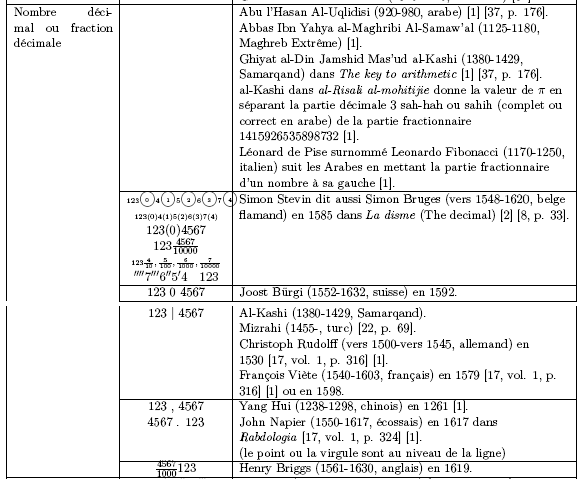- From: <lazrek@ucam.ac.ma>
- Date: Fri, 29 Feb 2008 10:42:37 -0000 (WET)
- To: Isam.Ayoubi@rubicon.com.jo
- Cc: "cj" <cj@mb-soft.com>, www-math@w3.org, www-math-request@w3.org
- Message-ID: <47394.196.217.150.21.1204281757.squirrel@web.ucam.ac.ma>
Hi All, Nowadays, numbers are written by hand and throw software, in a left-to-right direction. This situation is not a choose! Before, the same integer numbers were in use. They were presented in the same way but the reading and writing were in a right-to-left direction. However, the decimal part of a decimal numbers was positioned in the left of the integer part. That was the use almost all over the Arabic world. The same use took place in Europe to in 15e century (see the attachment file). Actually, there is big technical and pedagogical problems, concerning the direction numbers are written. In all the available software, modifying a number in an Arabic environment, without deleting it, never succeeds. In my opinion, after 10 years of investigation about mathematical presentation in Arabic, a suitable solution for this problem is still to be found. Azzeddine > Thanks Carl > > > Numbers is Arabic language are written in the SAME order as they are in > Latin languages - simply the 'numbering system' might change from country > to country. > > Meaning: 3.1415926535 would still be written in that order, regardless > of the direction of text & the number system used > > so in Arabic, the text goes: > > <--(direction of text) (continue the sentence ) 3.1415926535 ---> (the > number goes in this direction) <--(direction of text) (start the > sentence from here) .1 > > reason for that is that traditionally, in Arabic, umbers are read from > the smallest place value up: 321 is read one and twenty and three hundred. > so it actually follows the direction of the text in the reading & hence the > writing > > That is, the ltr & rtl have nothing to do with the writing of the > numbers, but has to do with the equation itself > > Regards > Isam > ====================================== > Dr. Isam S. Ayoubi > Managing Partner - Rubicon > P.O. Box 5296, Amman, 11183 - Jordan > Tel: +962.6.4655 300 or 4655 400 > Fax: +962.6.4616 800 > Mob. +962.79.5511332 > www.rubicon.com.jo email: Isam.Ayoubi@rubicon.com.jo > ====================================== > > > > > "cj" <cj@mb-soft.com> > Sent by: www-math-request@w3.org > 02/27/08 09:58 PM > > > To > <www-math@w3.org> > cc > > Subject > Arabic math > > > > > > > > > Your presentation on Arabic math notation is excellent. > > > However, I have one issue that I think is important, and I do not see > that you have addressed it there. > > It has to do with ltr and rtl presentation of Arabic numbers. The most > obvious example I have thought of is this sentence: > > The circumference of a circle is 3.1415926535 times the diameter. > > > If an Arabic writer translates that sentence into Arabic, the wording > begins flowing from right to left. But if it is required that the value of > pi is presented left-to-right, then the writer would have to skip ahead AN > UNSPECIFIC AMOUNT OF SPACE in order to then write the value in the > space. That seems immensely illogical and inconvenient to me. I would > think that all Arabic writers would necessarily write that sentence, words > and numbers, from right-to-left. In other words, after that writer writes > the Arabic words for "circle is", he would next write the 3 immediately to > the left of it, then the punctuation (whether decimal or comma) then the 1, > etc. > > It is the only logical way where an Arabic writer would not have problems > in providing appropriate space for the number value. When he is done > writing down the numeric value, with the final 5, at the left-hand end of > where he then was, he would simply and logically continue on with the > following words, "times the", continuing leftward. > > I realize that does not always seem to be done. But it seems the > "logical" > way that schoolchildren are taught the circle circumference relationship, > doesn't it? > > Carl Johnson > (Nuclear Physicist) > > > > > > > > -- > Ce message a été vérifié par MailScanner > pour des virus ou des polluriels et rien de suspect n'a été trouvé. > MailScanner remercie transtec pour son soutien. > > > -- Ce message a été vérifié par MailScanner pour des virus ou des polluriels et rien de suspect n'a été trouvé. MailScanner remercie transtec pour son soutien.
Attachments
- image/x-png attachment: DecimalNumber.png

Received on Friday, 29 February 2008 10:43:09 UTC